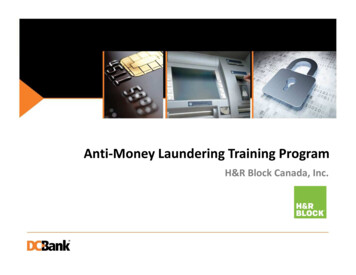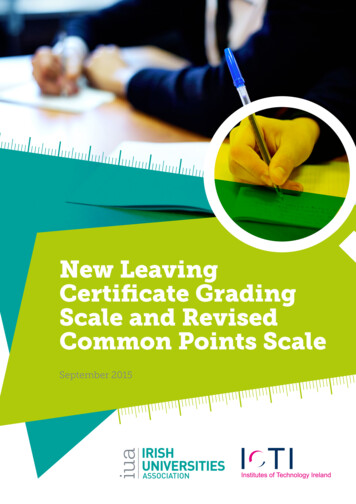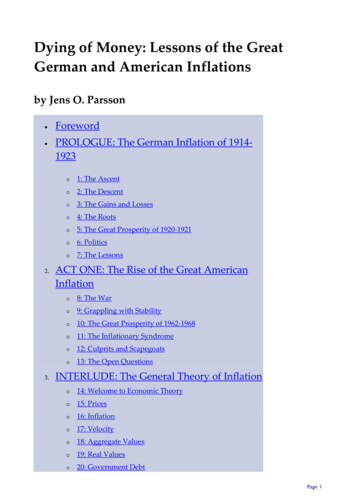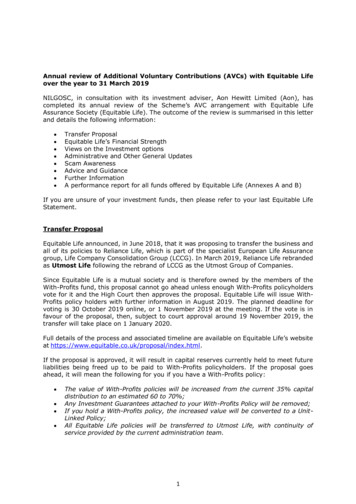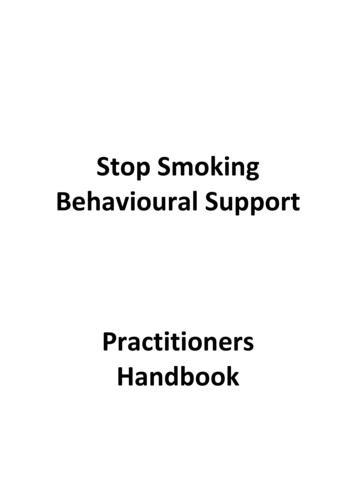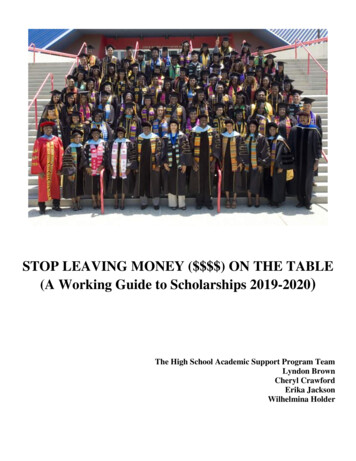
Transcription
STOP LEAVING MONEY ( ) ON THE TABLE(A Working Guide to Scholarships 2019-2020)The High School Academic Support Program TeamLyndon BrownCheryl CrawfordErika JacksonWilhelmina Holder
Dear Scholars and Families:This guide was written to support you in your search for money to go to college. Scholarships and grants areavailable for traditional college-bound students (those entering college directly upon high school graduation),those currently in college, returning adults, non-traditional students (35 years or older), and those attendingtechnical and/or trade schools. Millions of dollars are left unclaimed because no one applied for them.Historically, the number one reason students drop out of college is the lack of financial support. The HighSchool Academic Support Program Team wants you to take the time to position yourself for scholarships andgrants which is money that does not have to be repaid.We ask that you remain faithful to the process: researching, writing, following directions, meeting deadlines,and following up as required. Some scholarships may change throughout the year, while others may evendiscontinue altogether, but we strive to offer you the most updated information. You should supplement youronline research by visiting the scholarship websites to find the most up-to-date scholarship and financial aidinformation.The Team acknowledges this process can be challenging. Therefore, we share a few inspirational stories ofstudents who won scholarships and are going to college debt free.Good luck to you!The TeamWilhelmina Holder, EditorDecember 19, 20192
Students of Color Who Won Millions In Scholarship Dollars1If you are reading this, you are probably a college-bound student thinking about how you are going to pay forcollege.The High School Academic Support Program, shares these short bios of similarly situated, high achievingscholars and/or overcomers, who wrote their own narratives through determination, hard work, andperseverance.The common ground is the determination of these students to succeed - GRIT- to move ahead despite theobstacles that many of them have endured, or currently face. Despite family incoherence, the lack of basics:housing, food, clothing, and/or money, these students have made up their minds to go for it.Without looking in their rearview mirrors, these scholars decided to push forward. They will tell you it has notbeen, and probably still is not easy, but they did not give up or quit.“When the going gets tough, the tough gets going!!DYLAN CHIDICKNJ teen perseveres through homelessness to get accepted to 17 colleges. Formerly homeless student DylanChidick (Synder High) of Jersey City, NJ has been accepted to seventeen colleges. On Thursday, March 14,2019 Chidick received a full scholarship for tuition, room and board from "Give Something Back."Dylan Chidick, 17, of Jersey City got accepted to The College of New Jersey, his first choice, after 17 other acceptanceletters rolled in. (Photo: Courtesy of Lauren H. Adams/TCNJ)With the help of Village of Families, a HUD-funded housing program, Dylan and his family were able to acquire housing,where he could plan his college applications and await the acceptance letters. Since August, Dylan had been accepted into17 schools, including Rowan University, York College of Pennsylvania and Ramapo College.1Stories from the High School Academic Support Newsletter, April 2017, Vol. 1, Issue 13
NORMANDIE CORMIERLafayette teen accepted into 139 colleges, awarded 8.7 million in scholarshipsLeigh Guidry, Lafayette Daily Advertiser Published 11:37 a.m. CT May 25, 2019 ENormandie Cormier, 18, graduated from Early College Academy and South Louisiana Community College. Shehas been accepted to more than 100 colleges and awarded millions in scholarships. She's decided to attendXavier University in New Orleans this fall in her path to become a doctor. (Photo: Chantelle Gary)BENJAMIN HOLMESAlabama teen awarded more than 1 million in scholarships; accepted into 31 universities. Posted Mar 28,2019Benjamin Holmes, 18, is a Woodlawn High School senior who was awarded more than 1 million inscholarships and accepted into 31 universities. Getting ready for life after high school is a task 18-year-oldBenjamin Holmes started his freshman year after enrolling into Woodlawn High School's Early CollegeProgram. The dual enrollment program allows high school students to take college courses at Lawson StateCommunity College and UAB with all expenses paid — including books and transportation. The credits notonly go towards a student's college degree, but also suffices their high school requirements.With his 4.05 GPA and 52 college credits, Holmes will not only graduate in May as the valedictorian of hisclass, but he will also be eight credits shy from being a college junior.4
JORDAN NIXONBlack Girl Magic: Teen accepted into 39 colleges, awarded 1.6m in scholarship moneyHere's a shout out to Jordan from Douglas County High School! She has been accepted at a whopping 39 colleges anduniversities and offered over 1.6 million in scholarships. Congratulations, Jordan! March 9, 2019ANTOINETTE LOVEStudent offered more than 3.7 million in scholarshipsAntoinette Love, a high school senior in New Orleans, got into 115 colleges and was offered over 3.7 millionin scholarships. April 25, 2019JAKELIA BAKERA Georgia teen who was accepted into more than 50 schools and awarded over 1 million in scholarshipfunding is spreading hope for some people. Jakelia Baker, 17, told "Good Morning America." Baker, thevaledictorian of her 2019 class at Lucy C. Laney High School in Augusta, Georgia, said she currently has a4.1 GPA.RAWLIN TATE JR.Tate received more than 1 million in scholarship offers. He decided to attend North Carolina A&T inGreensboro on a full academic scholarship. Valedictorian Rawlin Tate Jr. Rawlin is the first African-American maleto be awarded valedictorian in WHS history, holds a 4.7 GPA, has taken 21 AP classes, participated in severalextracurricular activities, received over 1 million in scholarships offers, and will be attending North Carolina A&T on afull academic scholarship.5
Nia Muhammad, a recent graduate of Lane Tech College Prep, earned more than 3 million inscholarships as well as the Gates Millennium Scholarship.Some of the universities offered Muhammad full academic scholarships, including Princeton University, Yale University,the University of Southern California, the University of Pennsylvania, the University of Chicago and Stanford University.How a high school student won more than 1 million in college scholarshipsIn high school, Derrius Quarles was rebellious in class, disruptive and often late. But the words of a high school teacherhad a profound impact on his goals for the future. Through determination and creativity, Derrius earned more than 1.1million in college scholarships. Now he's paying it forward by advising other students on how to bridge the gap in fundingfor college.Derrius Quarles, a sophomore at Morehouse College in Atlanta earned 1 million worth of college scholarships, and isgoing to school for free. Quarles, who grew up in Chicago’s foster-care system became serious about college–and findingcreative ways to pay for it–after being inspired by a high school biology teacher, who became his mentor.Quarles, who hopes to attend medical school, won an astonishing 400,000 in private scholarships and another 750,000in scholarships from specific schools, such as Marquette University, Ohio State University and George WashingtonUniversity.CHRISTOPHER GRAYHow he won 35 scholarships and went to college for freeIt pays off to hunt down those private, obscure scholarships. Christopher Gray won more than 35 of them and went toDrexel for free. Getting a full ride to your dream college is practically unheard of if you're not a valedictorian who got aperfect score on the SAT. Even then, your financial aid award could still leave you with a hefty bill to cover. But don't6
give up hope. There are thousands of private -- and sometimes obscure -- scholarships out there from companies,nonprofits and community groups. While they may be harder to find and annoying to apply for, there's a good reason tohunt them down (besides getting Mom and Dad off your back).Ask Christopher Gray, who won more than 35 private scholarships. They helped him go to Drexel University inPhiladelphia for free. He graduated last spring and has some funds left over to use for grad school.To be sure, Gray spent a lot of time applying for hundreds of scholarships. He started during the summer before his senioryear of high school. And Gray is no slouch. He got good grades, founded a nonprofit and volunteered.He also came from a low-income family and received a federal, need-based grant, but that was capped at about 5,500 ayear."For me, it was either I apply for financial aid or I don't go. Scholarships were my only way out," he told CNNMoney.Since then, he's been on a mission to help others access the often untapped world of private scholarships. In 2014, helaunched his own app, called Scholly, which gives you an updated, personal list of scholarships you might be eligible for.It received backing from two investors on the TV show Shark Tank. Students using the app received about 15 million inscholarships this year, Gray said.Some private scholarships are pretty broad, but others are looking for someone specific. Left-handed? There's ascholarship for that. Passionate about improving Internet speed in rural areas? There's one for that, too.DARRIN FRANCOISDarrin FrancoisAt a time when admission seasons are getting highly competitive, a few high school students are beating theodds in rather incredible ways.Darrin Francois, a New Orleans high school student is one of them. He has received acceptances to over 80colleges and the congratulatory letters just keep coming.“I just applied, applied, applied. I didn’t know how many it was, so once they started to come through the mail,I was like oh my gosh, this many? Then, they started coming more and more. Now, today, I have 83 now,”Francois told WGNO.7
Harvard Bound for This Malcolm X Shabazz Newark Public High School Senior (Class of 2017)Malcolm X Shabazz High School Senior, Kim Boerrigter, has always strived to achieve the very bestaccording to school officials.Kim has received an award for perfect attendance every year since starting school, and when asked aboutmotivation in achieving excellence, Kim states, “My mom is my motivation. She’s always believed in me,has instilled within me great values and insists that I consistently stand up for my beliefs.”As valedictorian of Malcolm X Shabazz’s Class of 2017, Kim has been accepted into fifteen colleges.However, the proudest moment for Kim and her mom was her acceptance and receipt of fullscholarship to the prestigious Harvard University.With a passion for Science, Kim says that while attending Malcolm X Shabazz High School it has allowedher to broaden her logical scope.As a member of the Aquatic Biochemistry Team and working closely with club advisor, Mr. PatrickMurray, Kim has been able to broaden her scientific knowledge.“Mr. Murray has always reinforced and assisted me in facilitating my research. His support in this processhas been remarkable" Kim said.For Kim, education means, furthering her happiness and spreading the message that she’s going to be “ascientist who is a woman of color.”As a scholar athlete, Kim is the captain of the Cross Country track team, as well as the Indoor/Outdoor Trackteam.She is also a member of the Aquatic Biochemistry Team and the National Honor Society.In her spare time she enjoys playing basketball and reading. Her favorite author is Edgar Allan Poe. “I likehis style. It’s gloomy in a beautiful way.” Kim’s favorite poem by Poe is "The Raven".When asked about what it means to be a product of the City of Newark and Malcolm X Shabazz HighSchool, Kim states, “Individuals make assumptions about Newark. I feel that because I’ve emerged from aparticular zip code that I have to prove myself more than my counterparts.”Kim also believes that the majority of the skepticism stems from those who’ve never been to the inner city.“We have smart children here in Newark. We just need a few more resources and the belief that we can allsucceed. Being a Shabazz Bulldog has supported me and given me a tremendous amount of confidence. I’vealways wanted to attend Shabazz. Coming from "Brick City" has prepared me to face any obstacle set beforeme.”8
BRIDGING THE GAP: FINANCIAL AID FOR COLLEGEFinancial aid is help for meeting college costs, both direct educational costs (such as tuition, fees, andbooks) and personal expenses (such as food, housing, and transportation).People are sometimes surprised that students can get financial aid to help them pay for living expenseswhile living at home. Even colleges with comparatively low tuition such as community colleges, can givequalified students some help in paying for food, rent, commuting, and other personal expenses.Financial aid is also available for post-secondary vocational, trade, and other training programs whichmeet federal and state guidelines.ELIGIBILITY FOR FINANCIAL AIDAcknowledging that each program has specific requirements, the basic requirements which must bemust for eligibility require a student to attend on a part-time basis (usually defined as six semester hours ofcourses per semester or its equivalent) and/or require students to attend on a full-time basis, usually at least12hours per semester.You must also be enrolled in an eligible program at an eligible institution, maintain satisfactoryacademic progress toward a degree or certification, and be in good standing with the institution you attend.WHO GETS FINANCIAL AID?Many scholarships are based on merit and demonstrated need. Factors such as academicperformance, career plans, or special abilities are considered in addition to demonstrated need. Since theamount a family can afford to pay stays the same whether the costs are high or low, you could be eligible fordifferent amounts of aid at different colleges. In fact, you could get all the financial aid you’re eligible for andend up paying the same amount at a high-cost college as you would at a lower-cost one.The Free Application for Federal Student Aid (FAFSA) is the foundational application for all federaland state aid. Most colleges and universities also use this form to allocate institutional scholarships and grants.The application is available in English and Spanish.To apply for financial aid, you will need to complete the FAFSA. In order to do so, you will need to create youruser ID and password. If you are a dependent student both you and your parent will need to create user IDs andpasswords. You can also use the FAFSA4Caster to get an estimate of the amount of aid you may receive.Finally, even if you think you don’t qualify for federal student aid, complete the FAFSA. Many colleges awardinstitutional aid based on information required on the FAFSA. Likewise, third party sources of financial aidmay also require that you complete the FAFSA. FAFSA on the Web (English)The easiest way to complete a FAFSA is electronically on the web. When filing an applicationelectronically, as you answer key questions, other questions that you don’t need to answer are skippedover. This is called "skip logic". Completing the paper application does not provide that kind ofassistance. Additionally, filing electronically allows your college to receive the results and provide yourfinancial aid package to you much sooner.9
FAFSA en el Web (Espanol)La forma más facil para completar el FAFSA es por internet. Cuando se completa la aplicaciónelectrónicamente usted solamente contesta preguntas claves para su aplicación. Las preguntas que ustedno necesita completar son brincadas. Este proceso se llama “Skip Logic”. La aplicación en papel notiene este tipo de asistencia. Adicionalmente, al completer la aplicación electrónicamente agiliza eltiempo para procesar sus resultados y le permite a su College o Universidad determinar su elegibilidadpara ayuda mucho más rápido.FAFSA4CasterThe FAFSA4caster assists students and families by providing an early estimate of your eligibility forfederal student aid. You will also get a glimpse of what is necessary to complete the FAFSA on the Weband subsequently you can transfer the information you enter into the FAFSA 4caster to your FAFSA.To use the FAFSA4caster, visit www.fafsa4caster.ed.gov.Student Eligibility Requirements for Federal Student Aid Have a Valid Social Security NumberEnrolled in a Degree or Certificate Program at an Eligible InstitutionU.S. Citizen or Eligible Non-Citizen Registered with Selective Service (if required)Cannot Be in Default on a Federal Student Loan or Owe Repayment on a Federal GrantMaintain Satisfactory Academic Progress as Defined by SchoolDrug-Related Conviction May Result in DenialApplying for Student Aid Complete Need Analysis Form(s) FAFSAInstitutional Application (if applicable)Respond to Request(s) for Additional InfoTax Returns/Transcripts, Citizenship, Etc.Promissory Note (After Award Offer)Re-Apply Each Year: Aid not RenewableCSS Profile (if applicable)TYPES OF FINANCIAL AIDThe basic types of financial aid are described below. Because many financial aid programs are fundedby the federal and state governments, they are subject to change from year to year. College catalogs are goodsources for more detailed information about these programs. Additionally, students should contact the collegecampus financial aid offices.SCHOLARSHIPSScholarships are awarded on the basis of academic achievement and potential. The amount of theaward may depend upon the student’s financial need and vary depending on availability of funds. Read thescholarship’s eligibility to determine of you should apply. If questions arise, call or write the contact personlisted on the scholarship for more information. Scholarship awards do not have to be repaid.10
There are thousands of private sources of student financial aid provided through scholarships, grants, and lowinterest loans. While aid from the federal government, state government, and colleges constitute much of thefinancial aid, private aid does offer important assistance to students of different need levels and differentacademic standings. You might qualify for one of the many specialized scholarships available. Thesescholarships may come from corporations, religious groups, foundations, trade associations, clubs, veteransgroups, political groups, and many other kinds of organizations. The eligibility criteria, award amounts, andapplication procedures vary from program to program. Awards may be based on need, academic achievement,career plans, athletic ability, ethnic or racial heritage, religious affiliation, parents’ membership in a group, orany one of the other countless criteria.Federal Programs Pell Grant. The White House has announced that the maximum Pell Grant for the 2019–20 award year will be 6,195. The amount depends on your financial need, costs to attend school, status as a full-time or part-timestudent, and plans to attend school for a full academic year or less.State Programs (New Jersey)Tuition Aid Grant (TAG) Part-Time TAG (County College Students) Educational Opportunity Fund (EOF) NJSTARS(County College) NJCLASS Loan Scholarship Programshttp://www.hesaa.orgREMEMBER Apply Early Apply Annually Respond to College and/or State Request(s) for Information in a Timely Manner Contact Financial Aid Office if there are Changes in Family Financial Circumstances Watch Out for Scams!The University of Bridgeport NJ PromiseThe New Jersey Promise is a 6,000 scholarship that is given to all new, incoming full-time freshmen from New Jerseywhen they have applied and been admitted to the University of Bridgeport. We recognize that a major concern of collegeplanning is cost and we now provide the assistance to ensure that our private education is just as attainable as a publiceducation.Scholarship Scams Warning SignsYou have to pay a feeMoney-back offers or guaranteesCredit card or bank account information requiredProvides “exclusive” informationCommon Scams“Phishing” Unsolicited emails that bear the logo of your bank or credit card Appear legitimate but are traps to lure youinto giving out your personal or account information NEVER give out Social Security, credit card or bank accountnumbers to unsolicited emails or calls“Pharming” Unsolicited emails that encourage you to visit a website or click on suspicious linksMake sure your inbox spam filters are up to date BE CAREFUL about giving out your contact information or emailaddress11
Reporting ScamsNational Fraud Information Center (NFIC) File an online complaint at www.fraud.orgFederal Trade Commission (FTC)File an online complaint at www.ftc.gov/scholarshipscams, call 202-326-222, or write to: Federal Trade CommissionConsumer Response Center 600 Pennsylvania Ave., NW Washington, DC 20580State Attorney General’s OfficeFile your complaint with the Consumer Protection Division in your state. Visit www.naag.org to find your state AttorneyGeneral’s OfficeOffice of The Attorney GeneralState of New Jersey, Christopher S. Porrino, Attorney GeneralMain Number: 609-292-4925Citizen Services: 609-984-5828US Postal Inspection Service (USPIS)File an online complaint involving mail fraud at postalinspectors.uspis.gov, call the Crime Hotline at 877-876-2455 orwrite to: Criminal Investigations Service Center, 222 S. Riverside Plaza, Ste. 1250 Chicago, IL 60606-6100Better Business Bureau (BBB)File an online complaint about a business at www.bbb.org or call 703-276-0100.SCHOLARSHIP WEB RESOURCESScholly.comScholly – Scholarship Search Tool and College Scholarship Finder Apphttps://myscholly.comCollege Data Scholarship /scholar search tmpl.jhtmlAmeriCorps www.americorps.govCity Year www.cityyear.orgCSS/Financial Aid Profileprofileonline.collegeboard.comStudent Loanswww.studentloans.govFastweb: Scholarships, Financial Aid, Student Loanshttps://www.fastweb.com/ppcFree College Scholarship Searcheshttps://www.scholarships.comTo view scholarships available for Black and minority students, rity%2F%20DiversityTo view available for women students, n12
To view available for Hispanic/Latino students, spanic-latino-scThe U.S. Department of Education Resource Guide: Supporting Undocumented rting-undocumented-youth.pdf This resource released bythe U.S. Department of Education in October 2015 is an extensive guide aimed at helping educators, schoolleaders, and community organizations better support undocumented youth, including Deferred Action forChildhood Arrivals (DACA) recipients.National Council of La Raza http://www.nclr.org/ From this link, view the “Keeping the Dream Alive:Resource Guide for Undocumented Students” for tips on resume writing and fundraising for college.Latino College Dollars www.latinocollegedollars.org Visit this website for a database of scholarships forLatino college students, and information on how to plan and pay for college.Congressional Hispanic Caucus Institute Scholarship Database www.chci.org Visit this website for scholarshipopportunities for Latino students with a history of performing public service-oriented activities in thecommunity.Office of Congresswoman Lucille Roybal-Allard Scholarship Directory http://roybalallard.house.gov/students/ Visit this website for a list of scholarships, internship opportunities, fellowships,and links to other useful websites.Scholarships.com www.scholarships.com Visit this website for tips on how to conduct a scholarship search;who to ask for help at your school; how to prepare your scholarship applications, including tips on writing thewinning scholarship essay and creating a resume.ADDITIONAL RESOURCES FOR AFRICAN AMERICAN STUDENTSUnited Negro College Fund (UNCF): The country’s largest minority education organization awards scholarshipsand internships for low-income and moderate-income students at more than 1,100 colleges throughout the U.S.Black Excel: Provides a comprehensive list of scholarships for African Americans and minorities, including blackwomen.HBCU Network: HBCU Network provides resources for students at HBCUs including a comprehensive listing ofHBCUs in the United States, events, and career information for graduates or internship seekers.Black Career Network: Job board for African American graduates or those seeking internship opportunities while inschool.ADDITIONAL RESOURCES FOR FIRST GENERATION STUDENTSFirst In the Family: This comprehensive site features planning checklists, links, videos, and books for first-generationstudents seeking advice.ImFirst.org: Students can join this online community to get support and find resources to plan their college career as afirst-generation student.FirstGen Fellows: Provides information about community, nonprofit, and other programs across the country that supportlow income and first-generation students.13
RESOURCES FOR UNDOCUMENTED IMMIGRANTSUnited We Dream National Network (DEEP)unitedwedream.org/DEEP. If you would like to add resources on this list feel free to contactEducation Equity Organizer at cramirez@unitedwedream.org.Text EQUITY to 877877How to Fill out the FAFSA as an Undocumented Student21.The FAFSA does not require the citizenship status of the applicant’s parents, but does request their SSNs.Applicants must write in “000-00-0000” as the SSN for any parent or legal guardian who is undocumented.2.Applicants will encounter the following question: “Are you a U.S. citizen?” Undocumented students must checkthe box for “No, I am not a citizen or eligible noncitizen.”3.The form also features questions about the “legal state of residence” for the applicant and their parents. Thecorrect answer will vary, as each U.S. state has different requirements for legal state residency. Applicants shouldconsult their high school career counselor before completing this section.4.The online FAFSA form features an IRS Data Retrieval tool that allows applicants to submit their tax informationand that of their parents. If the applicant or their parents did not file an income tax return during the previous year,then tax information may be entered manually.10 Questions to Ask College Financial Aid Administrators31. Does the college meet the full demonstrated financial need for all four years, or is there unmet need (a gap)?2. How much on average do the college costs increase per year?3. Does the college practice front-loading of grants? Can students expect to receive a similar amount of grants insubsequent years, assuming their financial circumstances are similar? If the college practices front-loading of grants? Canstudents expect to receive a similar amount of grants in subsequent years, assuming their financial circumstances aresimilar? If the college practices front-loading of grants, how much will the grants change each year?4. What is the college’s outside scholarship policy? How does the college reduce the need-based financial aid packagewhen a student wins a private scholarship? Does the scholarship reduce the loan and work burden (and unmet need, ifany) or does it replace the college’s grants and scholarships?5. What are the residency requirements for in-state public college tuition?6. How many hours will I need to work to earn the full work-study award I've been offered? How much will I be paid perhour? Are work-study jobs readily available, or are they hard to get?7. What are the requirements for keeping my grants and scholarships in future years? Do I need to maintain a minimumgrade point average? Do I need to take a particular number of units? Do I need to participate in any special activities suchas community service?8. How does one appeal for more financial aid if the financial aid award is insufficient or the family’s financialcircumstances have d/hispanic-latino-scholarships/Fastweb, Evaluating Financial Aid Award Letters Quick Reference Guide. www.fastweb.com14
9. What percentage of first-time, full-time students graduate within a normal timeframe? How many years, on average,does it take to earn the degree?10. What percentage of students graduate with debt and what is the average cumulative debt at graduation?Problems and Pitfalls with Financial Aid Award LettersNo standard for financial aid award letters. There is no standard format for financial aid award letters, making themdifficult to interpret and to compare and contrast.Actual costs may be higher than the Expected Family Contribution (EFC). The EFC is not the price you pay. Financial aidpackages usually include loans, which have to be repaid, and there may also be unmet need. Some colleges use twodifferent EFCs, one for federal and state aid and another for the college’s own funds. Often the price you pay is muchhigher than the expected family contribution. On the other hand, the amount you pay will probably be lower than theoverall cost of attendanceInconsistent cost of attendance information. Colleges may use different definitions of the cost of attendance. Somecolleges only report direct costs, which are usually billed by the college, while some report both direct and indirect costs.You can find detailed cost information in the college’s catalog or on its web site. Make sure you have current figures foreach of the major costs, including tuition, required fees, room and board, textbooks, supplies, travel and transportation,personal expenses such as student health insurance and dependent care, and technology such as a computer.Cost allowances may be underestimates and unr
As valedictorian of Malcolm X Shabazz's Class of 2017, Kim has been accepted into fifteen colleges. However, the proudest moment for Kim and her mom was her acceptance and receipt of full scholarship to the prestigious Harvard University. With a passion for Science, Kim says that while attending Malcolm X Shabazz High School it has allowed




